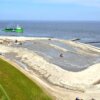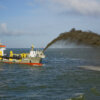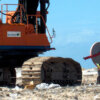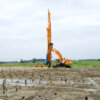Soil improvement is applied to both consolidate existing loose subsoils and sometimes specifically for compaction of newly reclaimed soil.
Aims of soil improvement
Soil improvement is typically implemented to:
- prevent excessive settlement of reclaimed land when it is being used for construction purposes (roads, airports, bridge and other foundations);
- enhance the soil stiffness and density to prevent liquefaction which can lead to damage to structures in earthquake-sensitive regions;
- improve the shear strength of the soil to prevent slip failure and increase the bearing capacity of the soil;
immobilise or stabilise contaminants in dredged soil in order to mitigate and preferably eliminate environmental impacts.
Options for soil improvement
Many options exist to successfully accelerate the consolidation of soils and dredged sediment for the development of newly reclaimed land as well as compaction methods to stabilise subsoils in vulnerable seismic areas. Each technique has its own advantages and disadvantages in relation to time, cost and performance.
Consolidation techniques
Consolidation techniques to stabilise new ground which take place over a longer period of time include:
- preloading or surcharging the area that is subject to consolidation with a temporary load of sand,
- using Prefabricated Vertical Drains (PVDs), sand drains and a system known variously as BeauDrain, Intensive Forced Compaction (IFCO) or Press-To-Drain (PTD); and
- vacuum consolidation.
Compaction methods
Compaction methods which take place in a much shorter period of time include:
- compaction with smooth rollers;
- High Energy Impact Compaction (HEIC);
- Dynamic Compaction (DC) – also known as heavy tamping;
- Rapid Impact Compactors (RIC); and
- vibroflotation.
Cement mixing
In parts of the world where soft subsoil is a serious problem for maritime construction, using admixtures to stabilise the soil may be a solution. This method is variously known as the cement deep mixing method, soil cement columns / piles, auger mixing, cement soil mixing, rotary mixing or just soil mixing.
Cement mixing methods are often applied for the foundation of:
- breakwaters, revetment and wharfs;
- seismic reinforcement of marine structures;
- foundations of bridge piers, tanks, railroads, roads, river dikes and buildings; and
- countermeasures for liquefaction.
They can also be applied to immobilise contaminated marine sediments.
Geotextiles
Geotextiles have many applications including filtration and drainage. Specific types of geotextiles can be used for embankment stabilisation and improving the bearing capacity of soft soil foundations on marine projects. Using a suitable geotextile can increase safety against underground failure and reduce the settlement of the subsoil foundation.
A well-managed soil improvement system appropriate to the site will enhance the prospects of on-time and safe project delivery.





















